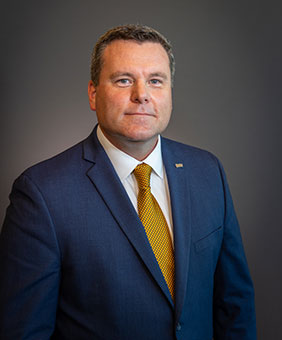National Adjutant Message

Barry A. Jesinoski, National Adjutant
Exploring every avenue to heal the invisible wounds of war
As long as humans have engaged in warfare, veterans have struggled with the invisible wounds of battle. While conventional treatments have helped, far too many are still left behind.
However, we’re living through what may be a watershed moment in medical research, as science is reopening doors once closed. Psychedelic-assisted therapies have revealed true potential in clinical trials to treat some of the most severe mental health conditions afflicting our community. This glimmer offers hope to veterans contending with not only post-traumatic stress disorder but also depression, traumatic brain injury, anxiety and other conditions in a world where the status quo is failing them.
While the Food and Drug Administration (FDA) has only approved one psychedelic medication—a ketamine nasal spray used to treat depression—other compounds are attracting the attention of veterans and researchers alike.
The FDA has granted breakthrough therapy designation—a regulatory status to fast-track drug development and review—for several psychedelic-based therapies. Psilocybin, the active compound in so-called “magic mushrooms,” received the status for evidence that it treats depression.
The FDA identified a drug similar to LSD as a possible breakthrough. Research has shown that a single dose of LSD, taken under the care of medical professionals in a clinical setting, can ease the burden of anxiety and depression for months.
While MDMA-assisted therapy was identified as a breakthrough treatment for PTSD in 2017, the FDA ultimately decided not to give its full approval. This decision was a disappointment to veterans, our members and supporters of psychedelic treatments, and it highlights the complexity of identifying and investigating these potent compounds in the current regulatory framework.
Still, we believe our nation owes veterans every opportunity to heal, and that means funding and pursuing this science. One such compound that has caught the nation’s attention is ibogaine, a psychedelic compound derived from the root bark of the African iboga plant, for its opportunity to heal the effects of traumatic brain injury. Veterans not only stand to benefit from this drug development but also lead the charge. When researchers studied dozens of special operations veterans who used ibogaine, they found the plant-based drug lessened depression and anxiety and improved functioning for those with traumatic brain injuries.
This awakening has led to Texas committing $50 million to research this emerging treatment, with states like Mississippi following its lead with legislative hearings.
Without veterans and their spouses sharing their stories of struggle and hope, it’s hard to see how our nation reached this defining moment.
The journey ahead will take time, but every step in this noble venture brings us closer to new treatments that could save lives and restore hope for countless veterans.
If you want to find out more about the National Adjutant, you can find his biography here.
